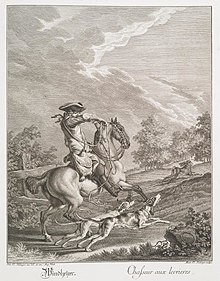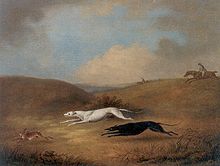Rabbit baiting

The hare baiting is a form of the hunt in the manner of the hunt for hares by greyhounds or other greyhound breeds that hunt the hare by sight and not by smell.
In German-speaking countries, it was operated on horseback, if possible, but also on foot. The greyhounds were led on a "chase rope" - which in turn was attached to a chase belt that was hung around the hunter - in order to avoid a miscarriage by chasing the dogs away too early. Only when a rabbit appeared at a distance of 50 to 60 paces or less were the dogs set loose. It was considered common and promising to use two to three greyhounds. Those who were successful on their own were particularly valued and they were called “ solo catchers ”, says Hartig . It was also widespread to send another greyhound with or after the former, which was trained to prevent the former from eating the hunted hare; This one was obviously called " Retter " or " Schirmer ".
This old hunting method gained popularity in the 19th century as a sport ("hare coursing"), especially in English-speaking countries but also in Spain and Russia. It was often carried out in the form of a competition. The largest British event was the Waterloo Cup , which was last held in 2005. The dog should prove its condition and agility. So-called “informal rabbit baiting” are often carried out with the aim of killing the rabbit. The owner of the killing dog often receives a cash bonus or the hunted prey.
In recent years this form of hunting has been the subject of controversy in the countries where it is still practiced. While some defend it as a traditional hunting practice, others see it as an unnecessarily cruel form of hunting. In England and Wales , the Hunting Act 2004 banned rabbit baiting as a method of hunting and hare coursing events with live rabbits since February 18, 2005 . Hare baiting is still practiced in other countries in a regulated form, in which an assessment of the dogs is often in the foreground. Countries where there is an unbroken traditional practice of baiting rabbits and where this form of hunting is not prohibited by law include the Republic of Ireland , Spain , Russia and the western United States . In Ireland, greyhounds have to wear muzzles so that the hare is not killed and the hares are released into the wild after the hunt.
There is no traditional form of hare coursing in German-speaking countries . However, the popularity of greyhounds as domestic dogs has resulted in so-called coursing competitions being held for them. Artificial towing phases are used as a prey dummy.
Legal situation in Germany

According to Section 19 (1) No. 13 of the Federal Hunting Act , hunting game is prohibited. Hackbarth / Lückert give as a (legal) definition for hunt : any form of hunting in which the hunted animal is held by the chasing animal before it is killed by the hunter. Since it is more painful for the prey to be killed by the greyhound, the hare baiting is even more to be regarded as a hunt within the meaning of Section 19 (1) No. 13 BJagdG.
According to § 3 sentence 1 No. 8 of the Animal Welfare Act , it is forbidden to set an animal on another animal, unless this is required by the principles of grazing-friendly hunting. Accordingly, no live prey may be used in coursing . The hare baiting as a hunting method was probably already unusual before the Reichsjagdgesetz 1934 came into force and does not represent a hunting act appropriate for pasture.
Web links
- ABC7 report of rabbit baiting in California ( February 10, 2012 memento on the Internet Archive )
- Irish Coursing Club website
- National Open Field Coursing Association website
Individual evidence
- ↑ Georg Ludwig Hartig in: Textbook for hunters and those who want to become one , Rötzl and Kaulfuss, 1812, Volume 2, p. 148 (digitized at Google Books)
- ↑ a b Johann Friedrich von Flemming in: The perfect teutsche Jäger , Leipzig, 1719, vol. 1, pp. 173-174 (digitized version of the HAB Wolfenbüttel)
- ↑ a b c Georg Ludwig Hartig in: Textbook for hunters and those who want to become one , Rötzl and Kaulfuss, 1812, Volume 2, p. 149 (digitized at Google Books)
- ↑ BBC England: End of the road for Hare Coursing. January 24, 2005 - accessed June 7, 2014
- ↑ Legal text of the Hunting Act 2004 at the Office of Public Sector Information (OPSI)
- ↑ Hansjoachim Hackbarth, Annekatrin Lückert: Tierschutzrecht: practice-oriented guide . Hüthig Jehle Rehm, Munich 2002, ISBN 3-7825-0436-4 , pp. 62 ( online ).